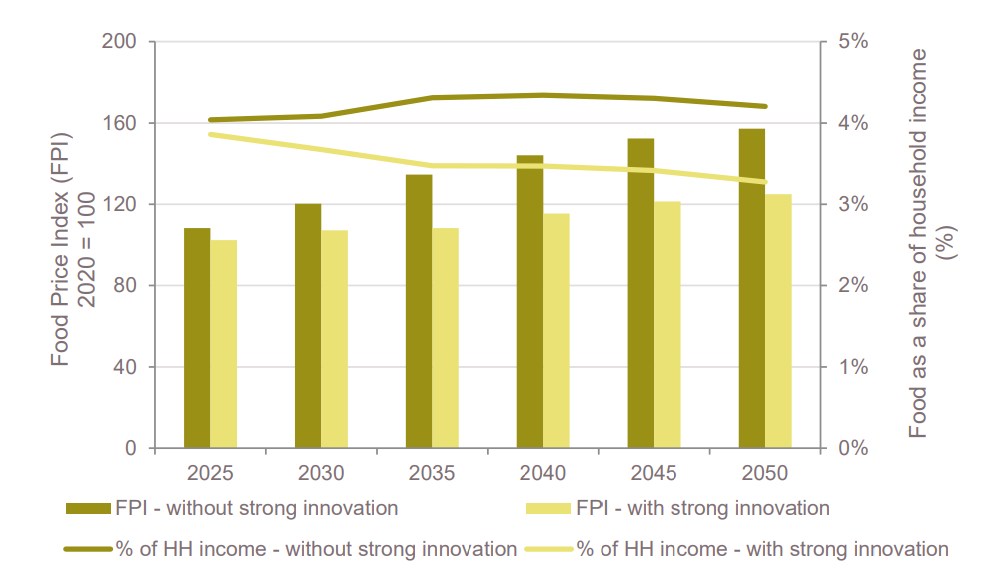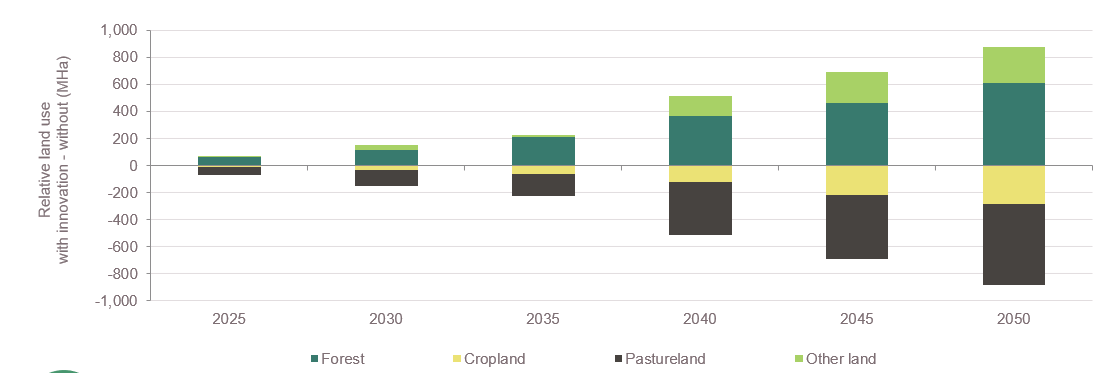Author: Global Innovation Needs Assessments Platform
A new project funded by ClimateWorks Foundation and the UK’s Foreign, Commonwealth, and Development Office, with analytical support from Vivid Economics, identifies up to $2.7 trillion of benefits from net zero innovation in 2050, including cheaper energy and food. To fully unlock these benefits, innovation support needs to ramp up now, both for RD&D (3x increase) and particularly for commercialization (8x increase).
The Global Innovation Needs Assessments (GINAs), launched 12 October, is a first of a kind platform for assessing the case for low carbon innovation. The GINAs take a system wide perspective, explicitly modelling the impact of innovations across the global economy. Uniquely, the analysis quantifies the economic benefits of low carbon innovation and identifies the public investment levels—from research and development to commercialization—needed to unlock these benefits.
The GINAs find that innovation unlocks 1) affordable decarbonized energy and food, 2) scales high value economic activity in low carbon supply chains, and 3) safeguards nature and health.
1. a) Innovation in both the energy and land systems reduce the cost of decarbonizing the economy by 28%, with savings around $2.7 trillion per year by 2050.
b)Innovation for net zero in agriculture reduces food prices.
2. Innovation can also scale high value economic opportunities worth GVA $3.4 trillion within large low carbon supply chains, supporting 37 million jobs.
3. Innovation for net zero provides a wide array of co-benefits, a particularly important one is the reduced need for land, enabling natural habitat restoration, reducing water demand, and improving biodiversity.
Delivering these benefits requires an 8x increase in commercialisation spending and large increases in RD&D in this decade. Historically, it takes 2-4 decades to fully commercialize a technology after demonstration. Achieving net zero by 2050 requires much more rapid commercialization. While pull policy is still under development for key technologies, innovation support will be critical to ensure technologies are ready for large scale deployment at lowest possible cost. This includes increased RD&D spending, but critically also involves public commercialization spending, to push technologies from small trials to full scale commercial deployment.
Note: Current RD&D spending for energy innovations is based on a subset of technologies in the IEA RD&D database that lies within the scope of the GINAs. Current commercialization spending is not tracked consistently globally and is estimated by Vivid Economics using available public spending data for wind, solar, CCS and hydrogen.
National innovation assessments can help governments set innovation priorities and collaborate with the private sector – as happened with the UK’s Energy Innovation Needs Assessments (EINA) project. The EINAs supported the case for innovation investment in industries that would provide the greatest benefit to the UK. The EINAs have supported several major recent UK Government announcements including the PM’s 10 Point Plan[1] and the Energy White Paper[2]. With similar national innovation assessments, governments can focus innovation spending on technologies that can drive domestic, low carbon, high value industries, taking into account existing competitive advantage.
Newsletter
Launch of the Global Innovation Needs Assessments
At the ClimateWorks Foundation and UK FCDO sponsored ‘Benefits and Need for Global Energy Innovation’ event, Jennie Dodson, head of MI Secretariat, chaired an innovation panel featuring Varun Sivaram, Ann Mettler, and Massamba Thioye. Building on the recently released Global Innovation Needs Assessments (GINAs), the panel discussed the possibility for national innovation assessments and the role for policymakers setting evidence-backed strategic direction of innovation. Mission Innovation was lauded for catalysing global cooperation on clean energy innovation and for strengthening informed decision-making. A recording is available in the event page.
The GINAs highlight how net zero innovation makes decarbonization technologies in energy and land-use affordable and available for mass market deployment – reducing the costs of decarbonizing the world by up to $2.7 trillion per year by 2050. It also highlights further including economic growth and nature and health safeguarding. To realize these benefits, commercialization needs to increase 8 times, and RD&D needs to triple. For more information about the GINAs, please access the GINAs website.
The event also featured Nick Bridge, the UK Foreign Secretary’s Special Representative for Climate Change, Patrick Child, Deputy Director General in DG Research and Innovation, European Commission, and Alex Kazaglis, Director at Vivid Economics.
[1]https://assets.publishing.service.gov.uk/government/uploads/system/uploads/attachment_data/file/936567/10_POINT_PLAN_BOOKLET.pdf
[2]https://assets.publishing.service.gov.uk/government/uploads/system/uploads/attachment_data/file/943807/201214_BEIS_EWP_Command_Paper_LR.pdf
